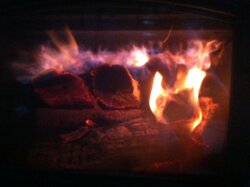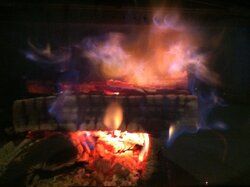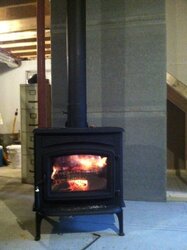So far I've had the 3 break-in fires and two "real" fires in my new stove. The last fire I had, the stove top reached 625. I shut the air all the way down and then kept shutting the damper until I had that closed as much as possible. The stove happily cruised along at 625 (see pic). It felt like it was on the edge of getting away from me.
The stove is in the basement of a ranch house. Stove pipe is 6" double wall to the ceiling. Chimney is 6" Class A - approximately 25 feet. It's a straight shot from the stove to the rain cap. Draft seems excellent.
I was burning soft maple that was over a year old. It was nice and dry. Secondaries burned no problem.
I started a small fire, burned it to coals and then put two layers of average sized splits in.
The only thing I can think of is the door gasket. I remember hearing a small whistling sound when I had my face in front of the stove to watch the fire.
I just did a dollar bill test. The top and bottom hold the bill tight. Near the hinge and near the latch I was able to pull it a little. Do I need to adjust the door already?

The stove is in the basement of a ranch house. Stove pipe is 6" double wall to the ceiling. Chimney is 6" Class A - approximately 25 feet. It's a straight shot from the stove to the rain cap. Draft seems excellent.
I was burning soft maple that was over a year old. It was nice and dry. Secondaries burned no problem.
I started a small fire, burned it to coals and then put two layers of average sized splits in.
The only thing I can think of is the door gasket. I remember hearing a small whistling sound when I had my face in front of the stove to watch the fire.
I just did a dollar bill test. The top and bottom hold the bill tight. Near the hinge and near the latch I was able to pull it a little. Do I need to adjust the door already?



 But, for sure, I don't get any whistle sound from my stove's door.. That doesn't sound right does it? My wind-whistle is very clearly coming from around the primary air control..
But, for sure, I don't get any whistle sound from my stove's door.. That doesn't sound right does it? My wind-whistle is very clearly coming from around the primary air control..



